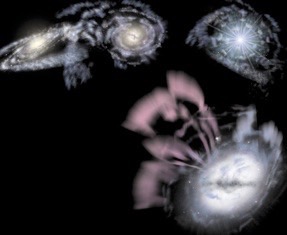
I am a theoretical astrophysicist, at TAPIR and the Burke Institute for Theoretical Physics at Caltech’s Division of Physics, Math, & Astronomy (PMA). I’m also a leader of the FIRE project.
I have the good fortune to be working on a diverse array of questions related to planet, galaxy, star, and black hole formation and evolution, as well as astrophysical fluid dynamics and plasma physics, and the origins and nature of dark matter and dark energy.
This is work with a large number of collaborators: check my Welcome page for links to their home pages.
Some questions we ask include: How do planets, stars, black holes, and galaxies form? How do stars and super-massive black holes impact or ``feed-back'' on the galaxies in which they live, and subsequent generations of star and black hole formation? What happens when galaxies and stars and black holes collide? How can we use this to relate seemingly diverse populations: quasars, ultra-luminous starburst-galaxies, gravitational wave sources seen by LIGO and upcoming gravitational wave detectors, and more? Where did the black holes we now measure in gravitational waves originate? Where did our solar system — and the thousands of new planets we are discovering — actually come from and how does the Universe create a planet from cosmic “stardust”? Are there new types of planets which we have not yet discovered, waiting out there? Are the first stars in the Universe anything like those around us, our Sun among them? What can we learn about fundamental plasma physics and fluid dynamics from astrophysical fluids (which allow us to explore regimes never seen on earth — super-sonic turbulence with Mach numbers of hundreds, in strongly-magnetized dusty plasmas)? Are there novel computational methods for solving differential equations which will allow us to make scientific breakthroughts in multiple fields with next-generation peta-scale and larger super-computers? What is the nature of dark matter? How can the next generation of telescopes and experiments detect and determine the nature of the dark matter particle? What consequences do these models have for the growth and evolution of structure in the Universe?
Our broader astrophysics & relativity group at Caltech (“TAPIR” for short) consists of a number of different faculty members and groups working on many inter-connected problems. Here’s a quick cartoon illustrating some of the different research areas and different faculty who collaborate on them, including myself, Katerina Chatziioannou, Jim Fuller, Saul Teukolsky, Olivier Dore, Tzu-Ching Chang, Mark Scheel, Sterl Phinney, Konstatin Batygin, Kathryn Zurek, Yanbei Chen, and others!
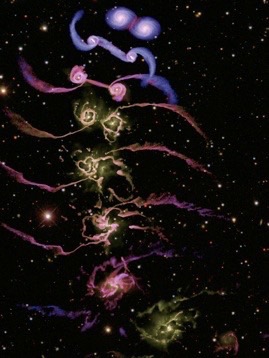
Interested in working with our group? See the opportunities listed on the Welcome page!
See our Press page for links to popular articles, describing our work for general audiences.
For animations (aka really-cool movies of simulations) and explanations of our work, see the Animations page above.
In the Talks section, you can listen to several recent(ish) talks I’ve given that have been recorded. These range from public talks intended for a broad audience, to technical conference presentations.
Links to Learn More:
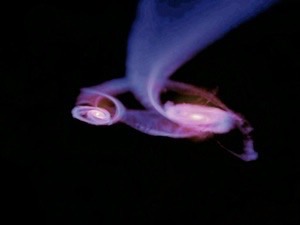
Press and Popular Media Coverage
Conference Proceedings, Talks, & Colloquia
Some advice and useful links for students who want to get started studying star and galaxy formation
The FIRE Project: Our current massive collaboration to study galaxy formation
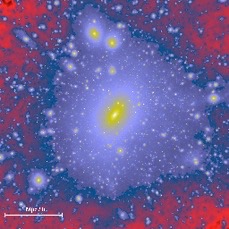
Simulation Codes we’ve developed:
Our new multi-physics (magneto-hydrodynamics + gravity) code, GIZMO, is described on this site (here)
A public version of the cosmological simulation code, GADGET, from Volker Springel, is available here.
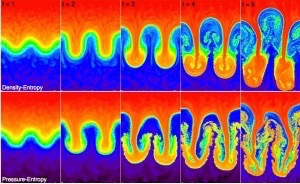
Pressure-Entropy SPH (P-SPH):
From a 2012 paper “A General Class of Lagrangian Smoothed Particle Hydrodynamics Methods and Implications for Fluid Mixing Problems,” available at: http://arxiv.org/abs/1206.5006
We discuss the fact that there are some known subtle problems with the treatment of fluid discontinuities in “standard” SPH prescriptions such as GADGET. We introduce instead the Lagrangian “Pressure-Entropy” formulation of the SPH equations which removes the problematic “surface tension force” and so substantially improves the treatment of fluid mixing and contact discontinuities.
A public version of this algorithm, implemented in the public version of GADGET-2, is available for download from this website (gadget2p.tgz).
Numerous code comparisons between this and ‘standard’ SPH are shown in the paper. But for a quick example, compare a movie (made very simply from an extremely low-resolution simulation) of the Kelvin-Helmholtz instability in ‘standard’ SPH and ‘pressure-entropy’ SPH.
Because of some proprietary conflicts, the full version of GADGET used to run some of the simulations shown here (which has been very extensively modified from GADGET-2 and GADGET-3) is not currently public. But please email me if you’d like to discuss obtaining a copy of the code.
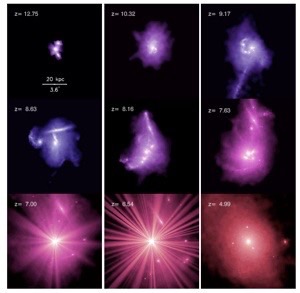
Other Public Data, Tables, & Routines:
Bolometric Quasar Luminosity Function :
(Hopkins, Richards, & Hernquist, 2006)